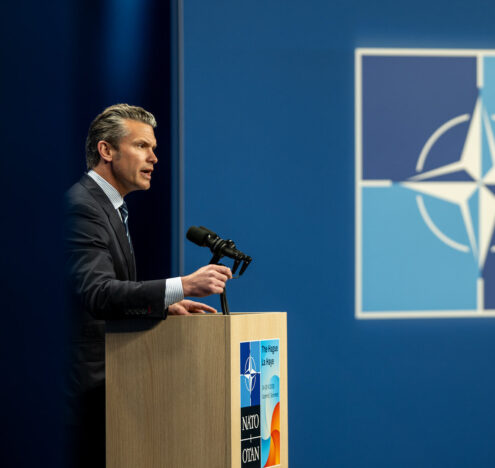While European and American political leaders continue to speak optimistically about progress on an elusive Armenia-Azerbaijan peace agreement, the likelihood of dangerous contingencies arising throughout the negotiating process cannot go ignored. Nor should the West inadvertently contribute to such risky possibilities. Like the lands that have separated Armenian and Azerbaijani armed forces in the over 30-year period since their independence from the Soviet Union and the First Nagorno-Karabakh War, the bilateral negotiating process is littered with minefields waiting to go off at every turn.
Following the Dec. 7, 2023 agreement between Armenia and Azerbaijan that included an exchange of prisoners, Yerevan’s backing for Baku to host the COP29 Summit, and Azerbaijan’s support for Armenia’s candidacy for the Eastern European Group COP Bureau membership, the bilateral track has seemingly become the dominant format for continued negotiations between the long-time rivals in the South Caucasus. This was further demonstrated in the subsequent April 19, 2024 bilateral agreement on the delimitation of eight miles of the parties’ shared border, a controversial agreement that has since provoked some unrest in Armenia.
Shopping for Mediators
Azerbaijan had previously achieved some of its key objectives while “forum shopping” for different mediators in Moscow, Brussels, and Washington. These successes included Armenia’s recognition of Azerbaijan’s territorial integrity (including the long-disputed region of Nagorno-Karabakh) and then the so-called international community’s apparent acquiescence to Baku’s military takeover of the region last September, which displaced more than 100,000 Karabakh Armenians who fled in another tragic episode of ethnic cleansing that has defined this conflict.
Since then, and with its power (and thus its leverage) over Armenia at its zenith, Azerbaijan has sought to block all third-party attempts at mediation that do not directly serve its own interests. Indeed, Baku expects (and with good reason) that it can secure its remaining key goals through these bilateral negotiations with Yerevan.
Armenia, on the other hand, although long a strategic ally of Russia, has since dramatically cooled on that relationship. This attempted disentangling is the result, in the words of Armenian officials, of Moscow’s unwillingness to abide by its security treaty obligations when Armenia faced repeated Azerbaijani military incursions between 2021 and 2022. (Moscow and Yerevan have a mutual defense agreement that dates to 1997; Armenia is also a founding member of the CSTO). To be sure, Yerevan has also sought a responsible party to deflect blame from its own strategic failures that contributed to Armenia’s precarious situation today.
Bolstering US and European Ties
In an attempt to demonstrate its displeasure with Russia and to strengthen its democratic resilience, Yerevan is significantly enhancing its political, economic, and, most controversially, security ties with the EU and the United States. These decisions, Prime Minister Nikol Pashinyan explained, are an attempt to “diversify” Armenia’s security sector, which has been almost entirely reliant on Russia since gaining independence. Pashinyan has said that his country’s strategy is to “maximally decrease our dependency on others.” To that effect, Armenia has also significantly enhanced its defense cooperation with India in recent years.
Armenia, on the other hand, although long a strategic ally of Russia, has since dramatically cooled on that relationship.
With Armenia increasingly eschewing Russian involvement in security matters and Azerbaijan restricting Western attempts to implant itself into the negotiating process and the South Caucasus region more broadly, Yerevan remains the weaker party in the talks over a long-expected agreement on the establishment of peace and interstate relations. Yerevan, admittedly, is seeking international guarantees for any agreement reached with Baku; however, Azerbaijan thus far has not signaled its willingness to accede to this demand.
The sheer power disparity between Yerevan and Baku simultaneously produces much fear and distrust in Armenia, while leaving Azerbaijan’s rhetoric yet more bellicose. The latter reinforces the former. While Armenian officials have so far mostly kept a strong face, the fundamental reality is that they are entangled in what appears to be a negotiating platform of last resort. If it fails, a likely alternative may be a return to open-conflict of one sort or another.
Protests in Armenia
In Armenia, protests, albeit of diminishing size, have persisted since mid-April against the government and what protestors view as its naïve policy of accommodation, if not appeasement, of an Azerbaijan that has demonstrated its interest in and willingness for extortionary practices.
While these protests, and their leaders, have several faults that make their likelihood for success appear slim, that prospect cannot be entirely ruled out. In fact, this is something Baku understands well. Azerbaijan benefits from a government in Yerevan that has taken a step back from its relationship with Moscow and is willing to engage in bilateral, lopsided negotiations. As such, Baku can, bit-by-bit, garner legitimacy and recognition for its recent gains and (it hopes) achieve others.
Therefore, Baku has some measure of an interest in not pushing too hard, if only for self-interested reasons. For Yerevan, there exist obvious legitimacy risks as the government moves forward with the very controversial and sensitive issue of border delimitation and demarcation.
Potential Outcomes
In this current context, it appears that there are three potential outcomes from this process.
The first, and the most optimistic, is that the negotiating parties continue their discussions in good faith and that both demonstrate a willingness to make meaningful concessions while preserving their key interests. This scenario could lead to the signing of an agreement before Azerbaijan hosts COP29 this November. Such an agreement would pave the way forward for the full demarcation of the shared border based on already agreed principles, the opening of all regional communication links, and eschewing the use of force.
The second would suggest that instead of the parties agreeing to settle their differences in a mature and responsible manner, the process becomes stalled and mired in controversial concessions. This could range from Azerbaijan’s continuing demands for Armenia to adjust its founding documents, disagreements over the technicalities of the opening of specific communications routes, or intractable disputes over the border delimitation process, to name just a few.
A negotiating process between Armenia and Azerbaijan that begins to stall poses several risks. From Azerbaijan’s perspective, there currently exists a window of opportunity with Russia still distracted in Ukraine and strong Western interest in seeing Yerevan and Baku reach an agreement. However, this window will not remain open indefinitely, and Azerbaijan has an interest in securing its demands sooner rather than later. How that may look in practice is not clear. Nevertheless, serious dangers do exist if the parties find themselves in a seemingly unresolvable standstill at the negotiating table.
Most Potentially Hazardous Outcome
A third, and most hazardous, scenario would result from a complete collapse of negotiations and thus a significant increase in the potential for renewed violence. The reasons for this collapse are wide ranging, and their consequences may be severe. This outcome could produce further domestic political instability in Armenia, reinvigorated use of force from Azerbaijan, and even the potential involvement of other regional actors if the situation were to evolve quickly. Especially in the context of significant changes on the battlefield in Ukraine or the potential return of Donald Trump to the American presidency, this scenario poses the most uncertainty and, therefore, most concern.
While all external actors have their own interests in these negotiations and their outcomes, the paramount objective must be to assist the sides in achieving a genuine, dignified, and sustainable agreement that will pave the way for the establishment of interstate relations and stability in the region. Although the EU and the US may harbor ambitions to weaken Russia in the region or push it out altogether, that goal would be unrealistic and would only spark more instability.
Stability at Risk
Geography matters. And as the case of Ukraine shows today, Russia has a deeply rooted interest in its western and southern borders the likes of which the EU, and certainly the United States, do not. This is not to say that the West does not have any genuine interests in the region.
Seeking an agreement between Armenia and Azerbaijan to reduce Yerevan’s sense of insecurity is a positive ambition, but not at all costs. Attempting to push Russia (and Iran) out of the region as part of such an agreement would only leave Moscow resentful and seeking to, one way or another, reinsert itself into the region. That would likely come at the cost of any momentary “stability.” Therefore, any true peace in the South Caucasus will need the support of the troika of regional powers — Russia, Turkey, and Iran — as well as the backing of the EU and US.
In the current international context, envisioning such an agreement that all these parties, not to mention Baku and Yerevan themselves, can come to terms with is a significant challenge. However, a dereliction of duty and a failure to support such a process would only lead to more regional instability in the South Caucasus.




















